2019.04.02.5
Files > Volume 4 > Vol 4 No 2 2019
INVESTIGATION / RESEARCH
The response of Faba bean (Vicia faba L.) varieties as evaluated by varied plant population densities in the highlands of Arsi Zone, Southeastern Ethiopia
Dereje Dobocha*1, Wogayehu Worku 2, Debela Bekela3, Zenebe Mulatu4, Fasil Shimeles5, and Almaz Admasu6
Available from: http://dx.doi.org/10.21931/RB/2019.04.02.5
ABSTRACT
Field experiments were carried out in 2016 and 2017 cropping seasons under on-farm conditions in Lemuna Bilbilo District, Southeastern Ethiopia to evaluate the effects of three varieties Degaga, Gora, Moti, and six plant populations (10, 25 (control), 30,50, 70, and 90 plants m-2) on faba bean specific yield and yield components. The experiments were laid out in a randomized complete block design in split plot arrangement in which varieties were assigned to main plots and plant populations to subplots with three replications. The year combined analysis of data revealed that seed yield, total biomass yield and test weight of seed were significantly (p<0.05) affected by varieties and plant population densities m-2. The highest seed yield (4649, 4594 and 4162 kg ha-1) was obtained at 90,70 and 50 plant m-2 for Degaga, Moti and Gora varieties respectively but, no significant difference between control for Degaga and Moti varieties. The highest total biomass of 9 t ha-1 was recorded from the highest 90 plant population m-2 though not significantly different to the total biomass obtained from 70, 50 and 25 (control) plants m-2. Gora variety significantly recorded the highest test weight of seed (889.2g) than the rest Degaga and Moti varieties. In short, founded on studied agronomic parameters of faba bean, 25 plant population density m-2 was economically recommended for Degaga and Moti varieties whereas, 50 plant population density m-2 was for Gora variety.
Key Words: Faba bean varieties, plant population density, seed yield, the test weight of seed
INTRODUCTION
Ethiopia is the second largest grower of faba bean in the world after the Peoples’ Republic of China1. It is an important pulse crop grown in the highlands (1800-3000 masl) of Ethiopia, where the soil and weather are considered to be congenial for better growth and development of the crop 2. It is a crop of high economic value 3 with its edible seed serving as an essential protein complement in the cereal-based Ethiopian diet, particularly for the poor who cannot afford animal protein 4. Even though the crop plays a significant role for Ethiopian farmers as a source of food, feed, and cash crop, the yield generally is below the world average due to several factors: poor crop management practices, lack of high yielding cultivars, stress inflicted by harsh environmental conditions and poor soil fertility can be listed as some of the causes of low yield 5. Central Statistics Agency in 2017 7 reported that the annual national mean faba bean grain yield is 2.11 t ha-1 which is quite low when compared with the yield potential of some of the recently released improved varieties. Crop density significantly influences yield and yield components of faba bean due to competition for limited resources in the field especially, for light, water and nutrients 7.
Plant density defines the number of plants per square meter, which in turn determines the area available to each plant 8. This determines the yield and productivity of a particular crop. Recently, Kulumsa Agricultural Research center has released a faba bean varieties Gora (large seed), Moti (medium seed) and Degaga (small seed) for the potential areas of the country with no specified plant populations per unit area and with seed rate of 200 kg ha-1 which is approximately 25 plants per meter square estimated from average test weight and seed rate of three varieties. Plant populations per meter squares vary with varieties in a given period. Since plant population m-2 has a direct effect on the cost of seed and final yield, information on this line is highly vital when a new variety is released, and growing environments are changed. Optimum plant density of a crop variety at one location may not apply at other locations because of variation in soil type and other environmental conditions; there is a need to develop site-specific recommendations. Therefore, the recommendation suggested at one time could be used for some time based on maturity groups and growth habit and other associated management factors. Hence, the objective of this study was to determine the optimum plant populations per unit area on yield and yield components of different faba bean varieties.
MATERIALS AND METHODS
Experimental Sites
The experiments were conducted at Lemuna Bilbilo District of Oromia Regional State, Southeastern Ethiopia under on-farm conditions (3 farmers' fields) during the 2016 and 2017 main cropping seasons. The experimental sites are located at 07º 31' 72'' to 07º 32' 79'' north latitude and 39º 13' 54'' to 39º 17' 31'' east longitude, altitude ranges of 2631-2817 meters above sea level. Nitosols dominated the soil of the area. Rainfall data recorded at experimental sites weather stations indicated that the rainfall was nearly normally distributed during the experimental years. The areas received an annual rainfall of 996 mm and 957 mm during the 2016 and 2017 cropping seasons, respectively (Figure 1). The mean maximum and minimum temperatures of the areas during the 2016 and 2017 growing seasons were ranges 20-20.3 OC and 3.7-4.2 OC, respectively. It was indicated that the highest mean maximum amount of rainfall was received in August and September respectively (Figure 1).
Experimental Design and Procedure
The experiments were conducted at Lemu Bilbilo Districts on three farmers’ fields for two years (2016 and 2017) main cropping seasons. The experiments were laid out in a randomized complete block design in split plot arrangement consisting of 3 faba bean varieties (V1 = Gora, V2 = Moti and V3 = Degaga) as main plot and 6 seed rates (SR1=10 plants/m2, SR2=30 plants/m2, SR3=50 plants m-2, SR4=70 plants m-2, SR5= 90 plants m-2, and recommended seed rate of 200 kg ha-1(25 plants m-2) as a control) as a subplot with 3 replications. Triple superphosphate (TSP), 100 kg ha-1, was used at time of planting. Other cultural practices were applied as per the recommendations. The size of the subplot was 4 m x 2.6 m, and the distance between subplot and blocks (rep) were 1 m and 1.5 m, respectively. All the recommended packages for faba bean production; two times hand weeding at 25-30 and 40-45 days after an emergency, a single application of 100 kg ha-1 TSP fertilizer along with seeds was applied for each treatment. Seedbed preparation was conducted using oxen plow based on farmer's practices.
Data Collected
Agronomic parameters collected included, seed yield per hectare, biological yield per hectare (seed yield plus straw yield), thousand seed weight (TSW), harvest index (HI) which is calculated by the ratio of seed yield to biological yield. To estimate seed yield of faba bean, plot sizes of 2mx3m (6 m 2) were harvested from each plot in December. After threshing, the harvested materials, seeds were cleaned, weighed and adjusted to 10% moisture level. The total seed yields recorded on a plot basis were converted to kg ha-1 for statistical analysis.
Statistical Analysis
The crop data were subjected to analysis of variance using the General Linear Model Procedure of SAS computer software version 9.1 (SAS Institute, 2002). Data were not combined over the year due to heterogeneity. Whenever treatment effects were significant, the mean differences were separated using the least significant difference (LSD) test at 5% level of significance.
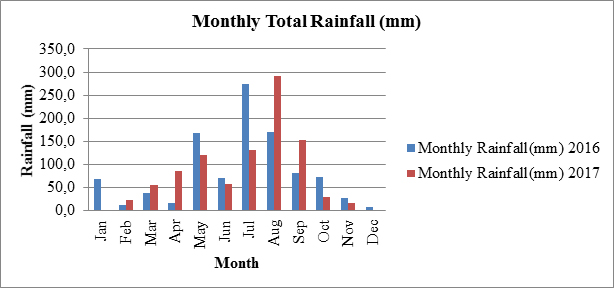
Figure. 1. Monthly Rainfall (mm) during the experimental years (2016-2017) at Lemu Bilbilo Districts
RESULTS AND DISCUSSIONS
Seed yield
Analysis of variance showed that seed yield was significantly affected by plant population m-2 and the interaction of varieties and plant population m-2 but, non-significantly affected by varieties (Table 3). The results showed that among the plant populations, ten plants m-2 (1998.4 kg ha-1) and 30 plants m-2 (3105.7 kg ha-1) gave significantly lower productivity than the control (3485.4 kg ha-1) (Table 2 and Figure 3). Similarly, Al-Suhaibani et al. (2013) 8 stated that when the planting density is too low each plant may perform at its maximum capacity, but there may be insufficient total plants to reach the optimum yield. Upon the relationships between plant density and yield Mellendorf (2011) 9 explained two concepts. First, maximum crop yield can only be achieved if the crop community can produce sufficient leaf area to provide maximum light interception during reproductive growth. Second, equidistant plant spacing maximizes yield because it minimizes plant to plant competitions. Therefore, the reduction in yield caused by high plant density (90 plant m-2) except for Degaga variety could be due to the competition between plants for this treatment begins during early vegetative growth. This new competition increases shading between leaves, leading to insufficient carbon fixation, increases respiration rate and increases intra-plant competition between vegetative and reproductive structures for assimilates. The result was in line with that of Al-Suhaibani et al. (2013) 8 who reported the seed yield per hectare was significantly increased with densities up to certain plant population m-2. A significant interaction between varieties and plant populations'm-2 on seed yield showed that irrespective of varieties there was a reduction in grain yield ha-1with reduced plant population m-2. The variety Degaga has grown with a 90 plants m-2 produced significantly higher seed yield of 4649 kg ha-1 than the other plant populations’ combinations except for 70 plants m-2 which exhibited the non-significance difference between two plant population m-2. There was also a non-significance difference between 70 plants m-2 and 25 plants m-2 (control).In conformity with the results, Dahmardeh et al. (2010) 10 stated that the highest and lowest seed yields were obtained with the highest and lowest plant density, respectively. The next best seed yield (4594 and 4162 kg ha-1) were obtained from Gora and Moti combined with 50 and 70 plants m-2, respectively but, non-significant difference were observed between 70 and control (25) plants m-2 for Moti variety (Table 1 and figure 2).

Table 1. Mean number of seed yield (kg ha-1) as affected by the interaction effect of varieties and plant populations
Means followed by the same letter(s) within a column are not significantly different from each other at 5% level of significance, ns: Not significant
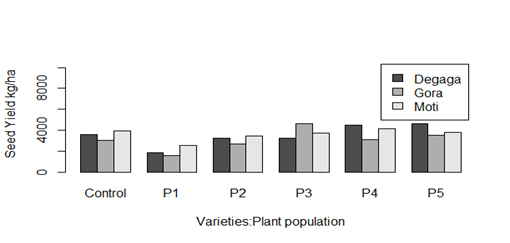
Figure 2. Interaction effect of plant populations and varieties on grain yield combined over sites and years.
Total biomass
The analysis of variance revealed that total biomass was significantly affected by plant population m-2, but varieties and the interaction of varieties and plant population m-2 were not significant (Table 3). The highest total biomass of 9 t ha-1 was recorded in the treatment sown with 90 plant population m-2 though not significantly different to the total biomass obtained from 70,50 plants m-2 (8 t ha-1) and control(7 t ha-1) (Table 2 and Figure 3). The lowest total biomass of 4 t ha-1 was recorded in the treatment with 10 plants m-2. The 50, 70 and 90 plants m-2 produced higher total biomass of 28.6 % and 14.3 % over the control, respectively. These results are confirmed by several faba bean investigators 10,11 who recorded the largest biological yield from the highest plant density due to an increased number of plants per unit area. These findings were similar to that of Badawy (2011) 12 who stated biological, and seed yields were significantly increased with increasing plant density from 22 to 44 plant m-2. Worku and Demisie (2012) 13 also reported that a large leaf area index at high plant density might attribute to improved light interception thus, ensuring high biomass and yield than at low plant density. Similarly, Dahmardeh et al. (2010) 14 reported higher biological yield in sandy loam soil in higher plant density due to an increase in the number of plants in the unit’s area.
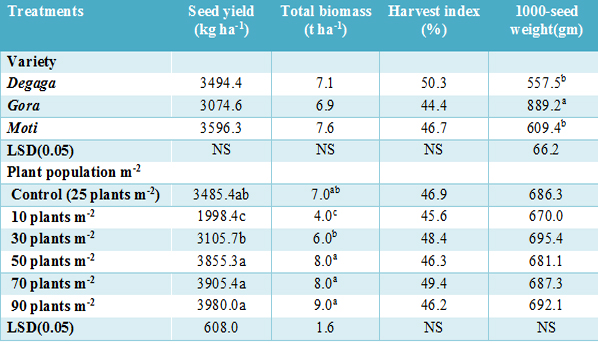
Table 2. Mean values of seed yield (kg ha-1), total biomass (t ha-1), harvest index (%),and thousand seed weight(gm), as affected by N and P combined over sites and years.
Means followed by the same letter(s) within a column are not significantly different from each other at 5% level of significance, ns: Not significant
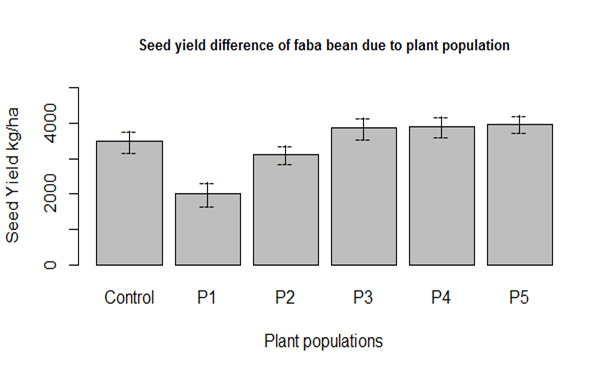
Figure 3. Effect of plant populations on seed yield of faba bean combined over sites and years
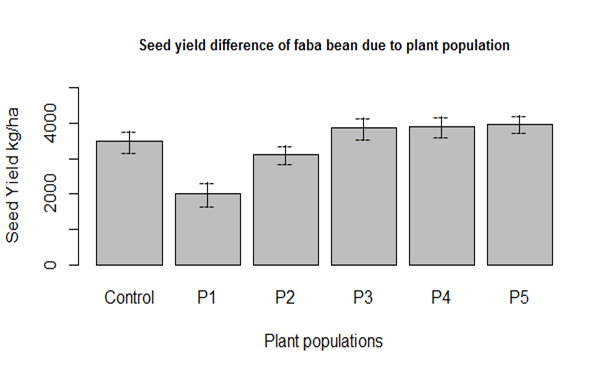
Figure 4. Effect of plant populations on total biomass of faba bean combined over sites and years
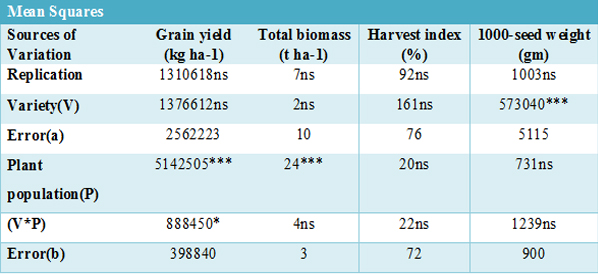
Table 3. Mean squares of seed yield (kg ha-1), total biomass (t ha-1), harvest index (%) and thousand seed weight(gm), as affected by main and interaction effects of variety and plant populations combined over sites and years
Means followed by the same letter(s) within a column are not significantly different from each other at 5% level of significance, ns: Not significant
Harvest Index (HI %)
The harvest index reflects the ability of the genotypes to partition its dry matter into seed and straw, and the ability to maintain the right balance between seed and straw yield(Al-Rifaee et al.,2004). The result revealed that the harvest index did not show a significant difference among varieties, plant populations m-2and their interactions (Table 3). Even though, statistically non-significance difference among varieties, the highest value of harvest index was recorded from the smaller seed size Degaga variety. This could be attributed to the rapid development of seed yield in smaller seeds, once the reproductive phase started so that the process of maturation proceeded quickly and led to a harvestable crop while weather conditions are right 15. Plant population 70 plants m-2 has resulted in numerically higher harvest index (49.6) over the rest plant population m-2 even if they were statistically non-significant (Table 2). Similar results were obtained by Kubure et al. (2016) 2 who stated the genotypes, plant density, and their interaction did not differ in harvest index. The result is in line with Khamooshi et al. (2012) 16 who reported the non-significant effect of plant density on harvest index of faba bean.
Test weight of seed (g)
Test weight of seed significantly responded to variety but was not significantly affected by plant population m-2 and variety plant population m-2 interaction (Table 3). This agrees with Thangwana and Ogola (2012) 14 and Gezahegn et al. (2016) 8 who reported the non-significant effect of plant density on 100 seed weight of chickpea and faba bean, respectively. Highest test weight of seed was recorded from Gora variety which was statistically different from Degaga and Moti varieties, but no significant difference among Degaga and Moti varieties in test weight of seed (Table 2). That might be due to the seed size difference of varieties. In comfort with the results, Bakry et al. (2011) 4 reported a significant effect between among faba bean varieties concerning test weight of seed.
CONCLUSIONS
The results revealed that among agronomic parameters considered only seed yield was significantly affected by the interaction of varieties with plant population density m-2. Total biomass was affected by plant population density m-2 whereas test weight of seed was affected by varieties. Variety Degaga has grown with a 90 plants m-2 produced significantly higher seed yield of 4649 kg ha-1 which exhibited the non-significance difference between 70 plants m-2.Inturns no significance difference between70 plants m-2 and 25 plants m-2 (control). The highest seed yield of 4594 and 4162 kg ha-1 were obtained from Gora and Moti combined with 50 and 70 plants m-2, respectively but, non-significant difference were observed between 70 and control (25) plants m-2 for Moti variety. The highest total biomass of 9 t ha-1 was recorded from the highest plant population m-2 though not significantly different to the total biomass obtained from 70, 50 and 25 (control) plants m-2 . The highest test weight of seed (889.2g) was recorded from Gora variety. In nutshell, based on seed yield and total biomass 25 plant population density m-2 was economically feasible for Degaga and Moti varieties whereas 50 plant population density m-2 was for Gora variety.
REFERENCES
1. Temesgen, T., Keneni, G., Sefera, T., & Jarso, M. (2015). Yield stability and relationships among stability parameters in faba bean (Vicia faba L.) genotypes. The crop journal, 3(3), 258-268.
2. Kubure, T. E., Raghavaiah, C. V., & Hamza, I. (2016). Production potential of faba bean (Vicia faba L.) genotypes in relation to plant densities and phosphorus nutrition on vertisols of central highlands of West Showa Zone, Ethiopia, east Africa. Advances in Crop Science and Technology, 1-9.3.
3. Tolessa, T. T., Keneni, G., & Mohammad, H. (2015). Genetic progresses from over three decades of faba bean ('Vicia faba'L.) breeding in Ethiopia. Australian Journal of Crop Science, 9(1), 41.
4. Bakry, B. A., Elewa, T. A., El Karamany, M. F., Zeidan, M. S., & Tawfik, M. M. (2011). Effect of row spacing on yield and its components of some faba bean varieties under newly reclaimed sandy soil condition.
5. Brink, M., Belay, G., & De Wet, J. M. J. (2006). Plant resources of tropical Africa 1: Cereals and pulses (pp. 54-57). Wageningen, The Netherlands: PROTA Foundation.
6. Tafere, M., Tadesse, D., & Yigzaw, D.(2012). Participatory varietal selection of faba bean (Vicia faba L.) for yield and yield components in Dabat district, Ethiopia, Wudpecker. Journal of Agricultural Research, 1, 270–274.
7. CSA (Central Statistics Agency) (2017). Report on Area and Production of Major Crops (Private Peasant Holdings, Meher Season): Agricultural Sample Survey. Central Statistics Agency, Addis Ababa, Ethiopia.
8. Kissi Wakweya, Reta Dargie, Tamiru Meleta (2016). Effect of Sowing Date and Seed Rate on Faba Bean (Vicia faba L.,) Growth, Yield and Components of Yield at Sinana, Highland Conditions of Bale, Southeastern Ethiopia. International Journal of Scientific Research in Agricultural Sciences, 3(1), pp. 025-034.
9. Gezahegn, A. M., Tesfaye, K., Sharma, J. J., & Belel, M. D. (2016). Determination of optimum plant density for faba bean (Vicia faba L.) on vertisols at Haramaya, Eastern Ethiopia. Cogent Food & Agriculture, 2(1), 1224485.
10. Al-Suhaibani, N., El-Hendawy, S., & Schmidhalter, U. (2013). Influence of varied plant density on growth, yield and economic return of drip irrigated Faba bean (Vicia faba L.). Turkish Journal of Field Crops, 18(2), 185-197.
11. Mellendorf, E.N. (2011). Soybean growth and yield response to interplant competition relief in various plant density environments. MSc Thesis, University of Illinois at Urbana- Champaign, USA.85 p.
12. Dahmardeh, M., Ramroodi, M., & Valizadeh, J. (2010). Effect of plant density and cultivars on growth, yield and yield components of faba bean (Vicia faba L.). African journal of Biotechnology, 9(50), 8643-8647.
- Kubure, T. E., Raghavaiah, C. V., & Hamza, I. (2016). Production potential of faba bean (Vicia faba L.) genotypes in relation to plant densities and phosphorus nutrition on vertisols of central highlands of West Showa Zone, Ethiopia, east Africa. Advances in Crop Science and Technology, 1-9.3.
14. Badawy, R. A. W. (2011). Effect of planting date and plant density on growth and yield of some faba bean varieties. (2011) Published by Cairo Univ., Faculty of Agriculture, Egypt
- Worku, W., & Demisie, W. (2012). Growth, light interception and radiation use efficiency response of pigeon pea (Cajanus cajan) to planting density in Southern Ethiopia. Journal of Agronomy, 11, 85–93. http://dx.doi.org/10.3923/ja.2012.85.93.
- Thangwana, N. M., & Ogola, J. B. O. (2012). Yield and yield components of chickpea (Cicer arietinum): Response to genotype and planting density in summer and winter sowings. Journal of Food, Agriculture & Environment, 10, 710–715
17. Dahmardeh, M., Ramroodi, M., & Valizadeh, J. (2010). Effect of plant density and cultivars on growth, yield and yield components of faba bean (Vicia faba L.). African journal of Biotechnology, 9(50), 8643-8647.
18. Al-Rifaee, M. O. H. D., Turk, M. A., & Tawaha, A. R. M. (2004). Effect of seed size and plant population density on yield and yield components of local fababean (Vicia faba L. major). International Journal of Agriculture and Biology, 6(2), 294-299.
19. Khamooshi, H., Mohammadian, N., Saamdaliri, M., & Foroughi, Z. (2012). Study on effect of plant density and nitrogen on yield and yield components of Faba bean (Vicia faba L.). Journal of Ornamental and Horticultural Plants, 2, 161–167.
Received:3 April 2019
Aproved: 3 May 2019
Dereje Dobocha*1, Wogayehu Worku 2, Debela Bekela3, Zenebe Mulatu4, Fasil Shimeles5 and Almaz Admasu6
Ethiopian Institute of Agricultural Research, Kulumsa Agricultural Research Center (EIAR/KARC), Department of Agronomy and Crop physiology, P.O.Box 489, Assela, Ethiopia
*Corresponding author E-mail: [email protected]
